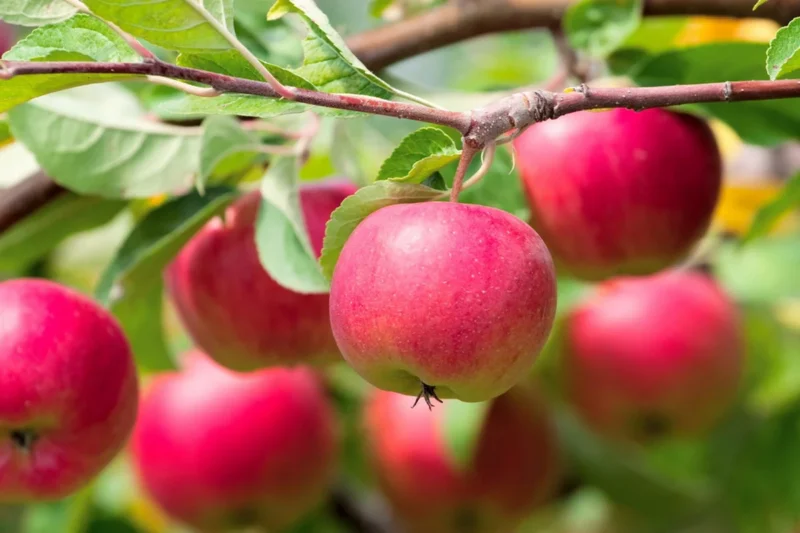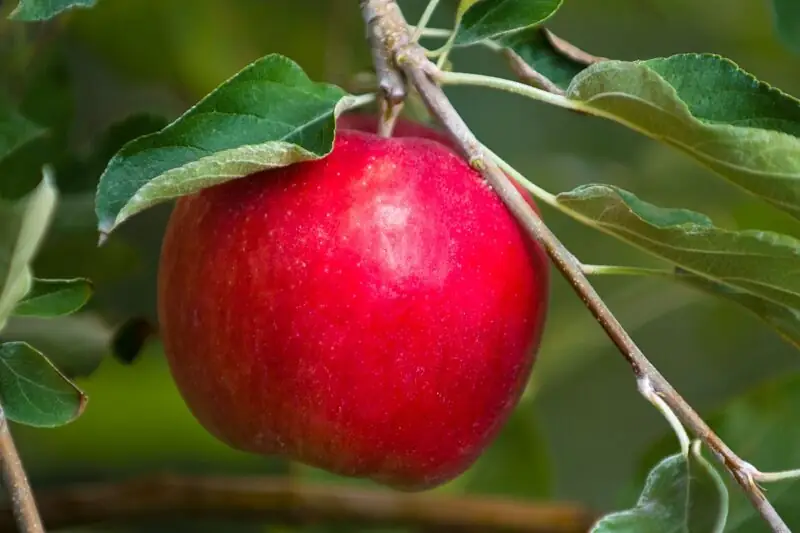Unlock the Secret of Growing Apples: How to Prune Your Apple Tree for Maximum Fruit Production

Today we’ll embark on a fascinating expedition into the world of the apple tree. This extraordinary adventure will cover the tree’s rich history, diverse cultivars, and the critical nuances of planting and care that turn a simple seedling into a thriving, fruit-bearing wonder. So, without further ado, let’s unravel the captivating tale of our primary subject: the apple tree!
What is an Apple Tree?
When you think of an apple tree, the image that likely comes to mind is a sturdy tree laden with beautiful, juicy apples. But that’s just the tip of the iceberg. The apple tree, scientifically known as Malus domestica, is an intricate species with a complex backstory. It’s a part of the Rosaceae family, known for its beautiful blossoms and deciduous nature.
At its core, an apple tree is a marvel of nature and human innovation. Its current form is a product of grafting, where a scion, the fruit-bearing twig, is attached onto a rootstock, forming the tree’s root system. This blend of grafting methods significantly impacts the tree’s characteristics, including its hardiness against pests, diseases, and environmental conditions. This combination also influences apple production, playing a crucial role in the quantity and quality of fruit per tree.
The Importance of Understanding Apple Trees
Knowledge of apple trees is a must-have, whether you’re an apple connoisseur, a budding gardener, or someone who appreciates the nuances of nature. Why so? Let’s peel back the layers. By understanding the different apple varieties, you can pick the perfect apple for your taste buds, from tart Granny Smith to sweet Red Delicious.
If you’re aspiring to plant apple trees, knowledge is your best friend. Recognizing the best time to plant, the optimal growing conditions, and how to care for young trees will give your apple trees the best chance to thrive. Plus, understanding apple trees’ pest problems and how to address them will help protect your trees and enhance their lifespan.
History of Apple
Origin and Cultivation History
Apples have a rich narrative that begins deep in the wild forests of Kazakhstan, where the apple tree ancestor, Malus sieversii, was discovered. The wild apple trees bore fruit more akin to crabapples, small and tart. But these apples had the resilience to survive, and that was enough for early humans.
Traders and explorers carried apple seeds along the Silk Road, leading to cross-pollination and the evolution of new apple varieties. This was the genesis of the apple’s journey from a wild forest fruit to the domesticated apple we enjoy today.
The Apple Tree in Mythology and Symbolism
As apples found their way into different regions, they also embedded themselves into various cultures, religions, and mythologies. In the biblical narrative, an apple signified knowledge and the fall of humankind. In contrast, in Greek mythology, apples symbolized immortality and were deemed worthy of the gods.
Spread and Commercialization of Apple Trees Globally
Fast-forward a few centuries, and apple trees found their way to North America, thanks to colonists. Apple trees, initially grown for cider production, gained popularity for their fruit. With the advent of grafting, apple trees could consistently produce more palatable fruit, leading to a surge in apple varieties and commercial apple production.
Apple Tree Cultivar

Understanding Apple Tree Cultivars
When we talk about apple tree cultivars, we’re referring to the numerous varieties of apple trees selectively bred for certain traits. Each cultivar brings unique flavor, color, and texture to the table, making apples a fruit of many faces.
Popular Apple Tree Cultivars
There are over 7,500 apple cultivars available worldwide! In North America, some of the most recognized are the McIntosh, famous for its tart and tangy flavor, perfect for a good cider, and the Honeycrisp, known for its extraordinary sweetness and crunchy texture. There’s also the versatile Red Delicious, a common sight in lunchboxes due to its mild taste and deep red color.
Choosing the Right Cultivar for Your Needs
Picking the right cultivar for your garden is an exciting challenge. The decision depends on your local hardiness zone, soil conditions, and personal flavor preferences. Remember, some apple trees require pollination partners, so consider planting two different apple varieties.
Hardiness and Hardiness Zone
Defining Plant Hardiness
Hardiness refers to a plant’s ability to withstand extreme weather conditions. For apple trees, this typically means their capacity to bear fruit even in cold winters. It’s an important characteristic to consider, especially if you live in regions with harsh winters.
The Importance of Hardiness in Apple Trees
Hardiness is vital in determining whether an apple tree will thrive in your garden. Some apple varieties are grafted onto dwarfing rootstocks, making the tree’s ultimate size smaller, but also reducing tree hardiness.
Understanding Hardiness Zones for Apple Trees
Every fruit tree, including the apple tree, has a specific hardiness zone — the geographic area where it can grow healthily. The zones are determined by the average minimum winter temperature. For instance, McIntosh apples do best in hardiness zones 4-7, where the winter temperatures typically don’t go below -30°F.
Planting Apple Trees
When to Plant Apple Trees
The best time for planting apple trees usually falls in early spring or late winter when the trees are still dormant and the ground is not frozen. This period provides enough time for the trees to establish their root system before the growing season starts.
Ideal Conditions for Planting
An apple a day may keep the doctor away, but only if the tree is planted right! Start with a sunny spot — apple trees need direct sunlight for at least six hours a day. Ensure the soil drains well to avoid waterlogged roots. The tree’s root ball should be level with the soil line to prevent rotting.
Steps for Properly Planting an Apple Tree
Starting with a good quality tree from reputable apple trees for sale in garden centers is always a plus. Dig a hole twice as wide as the root ball and just as deep. Place your apple tree in the hole and backfill with soil. After planting, water thoroughly, and voila! You’ve planted your apple tree!
Young Trees
The Growth Process of Young Apple Trees
The journey from a newly planted seedling to a mature, fruit-bearing apple tree is awe-inspiring. The first few years of growth are primarily focused on the tree’s overall growth and development rather than fruit production.
Care and Maintenance for Young Trees
Caring for young apple trees involves regular irrigation, proper fertilization, and pest management. In the first year, young trees need about one inch of water per week. Mulching around the trunk can help retain soil moisture.
Protecting Young Trees from Pests and Diseases
Young apple trees can fall victim to various pests and diseases, such as apple scab and codling moth. Regular inspections and appropriate preventive measures can safeguard your trees. In the case of a pest attack, organic or chemical insecticides might be needed.
How to Prune an Apple Tree
The Importance of Pruning Apple Trees
Pruning is vital to maintain a tree’s productivity and overall health. It helps increase fruit quality, reduce disease incidence, and make the tree’s structure stronger. It can also prolong the life of the tree.
Techniques and Best Practices for Pruning
Pruning apple trees involves a few basic steps. First, remove any dead, diseased, or broken branches. Then, remove any suckers growing from the base of the tree. Focus on creating a strong central leader and scaffold branches. Be careful not to leave the tree unpruned; this can hinder its growth and fruit production.
Pruning and the Health of the Apple Tree
Pruning not only helps the tree grow taller but also promotes a balanced structure and enhances fruit quality. Properly pruned and trained trees are less likely to break under the weight of their harvest. Remember, pruning is an art that will directly influence the tree’s productive life.
Common Pest and Pests and Diseases
Identifying Common Pests in Apple Trees
Common pests of apple trees include aphids, apple maggots, and codling moths. The presence of these pests can affect the tree’s health and reduce fruit quality. Regular inspection can help you identify these pests early and take the necessary actions.
Common Diseases in Apple Trees
Apple trees can also be susceptible to several diseases like apple scab, fire blight, and powdery mildew. These diseases can cause leaves to turn brown and fall prematurely, reduce tree growth, and affect apple production.
Strategies for Controlling and Preventing Pests and Diseases
The best strategy is to keep the tree healthy. A healthy tree can often resist pests and diseases better than a stressed one. Regular soil tests can ensure your trees get the nutrients they need. Use of proper insecticides and fungicides can help manage these common pest problems.
FAQs
Common pests include aphids, apple maggots, and codling moths. You can control them through various means, such as introducing beneficial insects, using insecticides, or setting traps.
The best time to prune an apple tree is in late winter or early spring before new shoots start to appear. This allows the tree to direct its energy to the new growth.
Choosing the right cultivar involves considering your local climate, soil conditions, and personal preferences. Local extension services or garden centers can provide advice tailored to your specific conditions.
Young apple trees need regular watering, especially in dry periods. Mulching can help maintain soil moisture. Regular inspections for pests and diseases can ensure your tree grows healthy and strong.
Conclusion
Understanding the apple tree is a journey that spans from its fascinating history to its diverse cultivars and care requirements. We have explored how apple trees grow, from the planting stage to when they become mature trees. We’ve also touched on the importance of pruning and how to manage common pests and diseases. Happy apple growing!